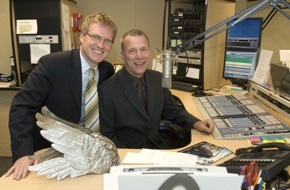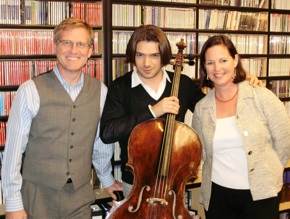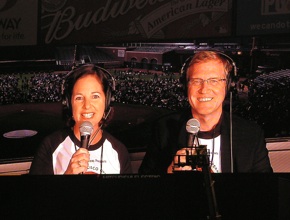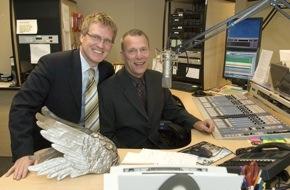This month KDFC, the Bay Area’s only full-time classical music radio voice, started Keeping Score: 13 Days When Music Changed Forever. It’s a series focused on Michael Tilson Thomas and the San Francisco Symphony, based around such seminal dates as April 22, 1723, when Bach was appointed Cantor by the Town Council of Leipzig.

But Bill Lueth has to look back only four months to find what he defines as “a very dramatic moment in classical radio history.” That’s when he discovered that his formerly commercial station was being sold by its owner, Entercom Communications Corp., to the University of Southern California, which would render it a public entity.
“The first feeling you have is, ‘Your girlfriend doesn’t like you anymore,’” Lueth reflects from his current office, where he serves as president of the newly created Classical Public Radio Network (CPRN). “I’d had a good relation with Entercom; I’d worked with them for the last four years. But at the same time, I’m not naive. I knew the [classical] format had threats to it on the commercial road.”
Fragile economics, augured by (but not limited to) the collapse of Lehman Bros. in 2008, had generated static in the business of radio. In fact, Lueth had earlier been implored to relocate to pilot station WQXR, which survived, along with its classical format, through acquisition by WNYC, New York City’s flagship public station. (Lueth, thankfully, opted to stay put.) As part of the business dealings of their former owners, both WQXR and KDFC were forced to surrender their frequencies and relocate to positions on the radio dial that had been occupied by lower-power stations. KDFC took the 90.3 FM spot from the eclectic KUSF, deemed unsustainable by its owner, the University of San Francisco, which was eager to unload it due to what it described as financial difficulties. In Boston, classical WGBH followed a similar path toward noncommercial, lower-power status.
Picking Up and Starting Afresh
Lueth quickly learned to cope with “so much stress and work” involved in the transition, though physically it involved a movement of only a few yards, to space subleased from Entercom at the corner of Third and Howard streets in San Francisco, just east of Moscone Center. He recalls long-time KDFC announcer Hoyt Smith, while off-mike during broadcast of a long piece of music, walking down the hall with a box of CDs, on the forced march from his old to his new roost.

Related Articles
Music Through the Mirror: How the Camera Lens Captures a Mahler Symphony
A new look at San Francisco Symphony’s Keeping Score.
KDFC Goes Public
SFCV Editor Michael Zweibach talks to KDFC Station Manager Bill Leuth about the change.
“Hoyt had this glum face, and I said, ‘You look like you’re in a bummer mood.’ He said, ‘Well, it’s kind of melancholy for me, they’re moving in a new station already; they can’t wait for me to get out of there.’ And I said, ‘But Hoyt, that old station was the station with the death spiral in commercial radio. And this new one is the station of hope.’ Since then, he’s been telling people that that changed his mind and turned him around, attitude-wise.”
There are already credible, tangible reasons to hope. “We were able to contract out engineering, and also to buy a monthly deal with Entercom to help us with some engineering internally,” Lueth points out. “On-air, the core group we took was Hoyt Smith, Dianne Nicolini, and Rik Malone. Then I just hired Ray White to do afternoons; he was a part-timer. Back when the economy hit, we’d gone down to just two covering big shifts (Dianne and Hoyt), and now we’ve been able to expand back to three full-time main announcers. And we have our own accounting person, and we’re not sharing a production person anymore.”
Broadening the Base
The absence of advertising on the now-public station has allowed Sales Manager Len Mattson to switch to securing underwriting. “There’s a lot of arts groups who need us to help sell tickets,” notes Lueth, as well as a number of corporate sponsors eager to display their support of the classical format. There’s a collateral impact on programming, in that “We don’t have to stop so much for commercials.”
And, more significantly, “We no longer are driven simply by aiming at the target demographics of a commercial station’s needs. We knew that Madison Avenue and the advertising community wanted an audience under the age of 55, and we really worked hard at targeting those people — playing the music in a certain way and style. Now it opens up: It’s the people’s station now.”
How is the new KDFC better serving people of all ages and tastes? “We play a lot more full-length pieces,” Lueth replies. “We’re programming for people who are multitasking. Television, for most people, is the activity, but radio is on with your activity, it’s not the activity. And now we have the Metropolitan Opera, which came back the first weekend that we became public.” The Met is again weekly, with live Saturday morning broadcasts during the company’s season; and the San Francisco Opera appears on the first Sunday of every month, all year. Sunday mornings, there’s the weekly Sacred Concert. And, “We’re probably going to build a new modern music show at some point,” Lueth promises, “but it won’t be in the middle of the day, by any means.” On Saturday nights, starting this summer, KDFC will be showcasing music festivals from up and down the West Coast, including our local Music@Menlo and the Carmel Bach Festival.
Signal Strength and Internet Presence
With the loss to the (quite groovy) classic rock station KFOX of the old, higher-power 102.1 frequency and its booster atop Mount Diablo in Contra Costa County, KDFC is concerned about who’s able to hear it, and how. “We’d averaged about 650,000 listeners, with another 75,000 online, which was ranked second or third, after New York and L.A.,” Lueth notes. “Now we’ve lost half of those listeners, because we can’t get to the South Bay.” Reception in the East Bay and some parts of San Francisco is also fragile.
Some of the faithful have fled to the Internet. “Our online numbers have jumped through the roof. We were already the biggest station in town online, and we grew 50 percent [beyond that], in a month. We also have a lot of people using our new iPhone app, to listen where they might not otherwise, and a lot are buying these devices [Squeezebox] that help you stream Internet feeds through your stereo at home.”
There have been, and will be, further efforts to bolster the over-the-airwaves signal, vital to listeners behind the wheel. KDFC acquired the 89.9 frequency, in the Wine Country, at the beginning of this month, and is also working to establish a South Bay signal. The inherited 90.3 transmitter at the University of San Francisco will soon be replaced by an updated and more far-reaching unit, set atop Mount Beacon in Sausalito.
Listening to Listeners
Since undergoing its own commercial-to-public conversion in October 2009, WQXR, which is no longer “The Radio Station of The New York Times” as heard by millions over several generations, has been “continually working on branding and other visibility standards and campaigns,” in the words of its vice president, Graham Parker. He believes that, lacking the massive governmental support received by the BBC in his native England, “the excitement in a noncommercial world is figuring out how to take this extraordinarily rich and deep and well-respected product, which is classical music radio, and making it sustainable, through these various funding methods. It’s a wonderful thing to witness, when we’ve done pledge drives and mailings.”

Those drives, adds WQXR Program Director Matt Abramovitz, can function as “a referendum on what we’re doing,” during which listeners are invited to call in with criticisms and suggestions. “We really want to reflect the community and take advantage of the fact that we’re in New York City,” says Abramovitz. He points to the station’s use of WNYC’s Jerome L. Greene Performance Space, located on its premises, to host broadcasts with a live studio audience. These have included a week-long chamber music festival, plus conversations with visiting artists. “We do Webcasts with that. So you could hear it online, you could hear it on the air, and you could hear it in person. Our operating assumption is, if you don’t like classical music, it’s probably because you haven’t really heard it.”
The station’s many fans, old and new, will be hearing continuing broadcasts, at the new 105.9 FM frequency and online, Saturdays from the Met and Thursdays from the New York Philharmonic, as well as the weeknight Symphony Hall shows, in partnership with such ensembles as the Chamber Music Society of Lincoln Center and the Orpheus Chamber Orchestra. Parker, the former executive director of Orpheus, expects that, during live concert broadcasts, “the audiences who are physically there will get a reminder that ’QXR is helping make the night possible, not only for them but for hundreds of thousands of people who are listening at home.”
But there’s also new stuff to be heard, including remote broadcasts from Le Poisson Rouge club. “It’s on the more exploratory, avant-garde end of the classical music genre,” says Parker. “And we have a separate Internet station called Q2, which is dedicated to contemporary music only. It’s a digital audience, with an international focus and live chats. Sometimes thousands of people show up and engage with these chats while the live broadcast is going on.”
The “Something for Everyone” Model
KING-FM in Seattle is turning noncommercial on May 2, yet has long enjoyed the sort of Internet presence you’d expect from a classical station that counts Microsoft and RealNetworks among its close neighbors. Highly placed classical music fans in both corporations convinced their employers to stream the KING-FM signal over the ’Net for free — for a while — and they’ve positioned themselves on the station’s advisory committee.
Bryan Lowe, who functions both as KING-FM’s program director and its new media director, happily admits that he and several of his staff are “pretty geeky guys,” because it places them at the forefront of classical radio’s evolution. “In 1995, we were the first station in the world to Webcast a live symphonic concert,” Lowe remarks. “It was called ‘The Cyberian Rhapsody,’ and it had the Seattle Symphony and some rock groups.”
About four years ago, KING-FM, which had been “walking the middle ground, to be most things to most people,” on a frequency of 98.1, began separating its Internet offerings into “channels,” inspired, in part, by the diverse classical offerings on satellite radio. “The first thing I added was the Evergreen Channel,” says Lowe, “to approach that part of the audience that just wants to relax. You can imagine all the Chopin, Debussy, and Ravel, and the Mozart symphonies and movements, and a tiny bit of crossover. It’s online, but if you have an HD [high definition] radio, you go to HD-2; HD-1 is our standard signal. The next channel we added is Symphonic Favorites, which is also on HD-3. It’s built like a concert hall, and it often includes very challenging pieces, which make for great concerts but not necessarily great radio.
“Then we have the Seattle Opera Channel,” Lowe continues, “where we have opera on 24/7. We also have the Arts Channel On Demand, where we interview people in film, literature, dance, and classical music. We also have an iPhone app, where you can flip between our channels, and it displays what it’s playing.”
Playing to the Hometown Crowd
Content-wise, KING-FM, like the other stations, has tried to show its pride of place. Its weekend program, broadcast on its standard frequency and called “Northwest Focus,” previews concerts by local ensembles and offers some of its music on-demand. The station has been carrying the Met broadcasts, and will also feature the Seattle Opera and other companies. “We’ll be adding symphonic concerts from across the world,” adds Lowe, “and a choral program, and a program called ‘Sunday Baroque.’”
Facing divestiture from commercial backing, Lowe is confident that “The Northwest is going to join us as a community radio station. The lion’s share of our funding will be in listener support, but many of our current advertisers have already expressed an interest in following us as underwriters.”
Similarly, back in the Bay Area, KDFC’s Bill Lueth hopes that his listeners and underwriters will prevail in public support for making an old art form heard in a new world. “I want them to think that we bring something to their lives, that we’re not simply a museum,” he says. “We’re not some place to visit. We’re a place to live with.”

